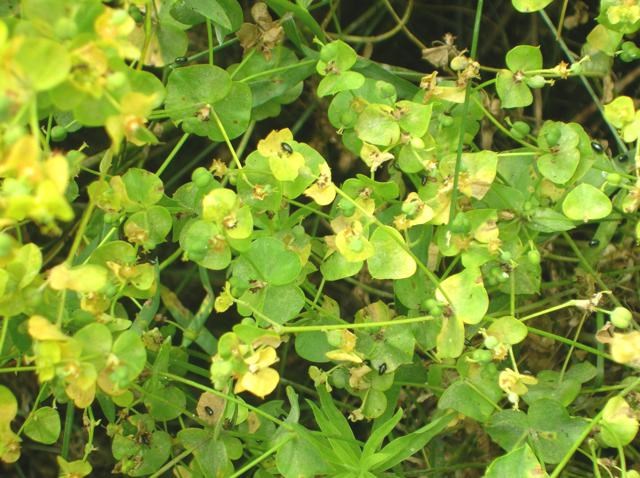During the 19th century, a beautiful plant made its way to North America. The yellow flowers are bright and vibrant during the summer, and in the fall, the plants turn beautiful reds, purples and oranges. Although the splendor of these plants can impress the untrained eye, in reality, they are an invasive nuisance weed that can be detrimental to ecosystems and agriculture.
This plant, leafy spurge (Euphorbia esula), is a very aggressive invasive plant. It has a deep root system and can produce thousands of seeds. Since this plant is exotic, it has no natural diseases or predators. As a result, leafy spurge can spread easily and quickly. Once established, it can outcompete native vegetation and be very damaging to habitat for species at risk. Southwestern Saskatchewan is home to many species considered to be “at risk”. How does one plant impact their habitat?
These species, such as the Sprague’s Pipit (Anthus spragueii), require native prairie for maintaining and growing populations. The Sprague’s Pipit, for example, strongly prefers to nest and forage on large parcels of native prairie. Leafy spurge, because it is so prolific, replaces the native vegetation. It changes the structure of the pasture, creating a habitat that is no longer useful to species.
How is this weed controlled? Well, it is not easy! There are chemicals will kill spurge; however, they cannot be used near water and can be very expensive. Mechanically, plants can be pulled or dug out at the roots, mowed before seed set, or cultivated on cropland. A few species of flea beetles and a species of hawk moth that have been introduced can be effective in damaging the plant and therefore weakening it. Small ruminants, such as goats and sheep, can also be used to control leafy spurge. Sheep will consume 50-60 per cent leafy spurge in their diet, and goats will consume 90 per cent leafy spurge. Grazing can reduce the canopy cover of the spurge and allow native vegetation to better compete.
Although each method of control has advantages and disadvantages, no method will completely eradicate leafy spurge with one attempt. Depending on the amount of leafy spurge, and how long the infestation has been in an area, it could take several years to reduce the spurge to a controllable amount no matter which method of control is used.
Lee Sexton has been working with, and learning about, leafy spurge for many years. He has a lot of information to share, especially about target grazing of leafy spurge. At a presentation this summer, Sexton made the point that “doing nothing about leafy spurge, is the worst thing a person could do”. Landowners need to look at what their land is worth now, and what it would be worth in the future. How would a leafy spurge infestation affect the land’s value? How will leafy spurge affect the carrying capacity of a pasture, or the quality of a crop? Investing money into the problem may seem ineffective, however those costs will perpetuate the wanted plant species and increase grazing capacity, which increases holding capacity. This, in turn, produces more pounds per acre, therefore more profit.
“Perhaps the best way to deal with leafy spurge is to do an integrated approach”, said Sexton. Coming up with a plan of action, using proper tools is important. Long-term, multi-species grazing along with other biological control (i.e. beetles), is an environmentally and economically sustainable solution.
Small ruminants can consume a substantial amount of leafy spurge. Timing grazing just right will enhance the effects of small ruminants on the leafy spurge. One method used with small ruminants is the “twice-over method”. With this approach, the spurge is lightly grazed in early spring. This will cause the spurge to re-grow, with new shoots. Creating these new shoots weakens the root reserves of the plants, making it more vulnerable to future grazing. The second time around, the animals will graze the plant again, removing potential of seed development. At this point, the spurge should be grazed heavily.
Using small ruminants and insects gives the opportunity for controlling leafy spurge in hard-to-reach and sensitive areas, such along a body of water. Like any method of control, grazing and insects will take a few years to significantly diminish a leafy spurge infestation. Long-term, investing the time and money into controlling leafy spurge will help ensure healthy pastures and habitat, better profits and will help maintain land values.
The South of the Divide Conservation Action Program (SODCAP Inc.) is a local stewardship organization that was formed by stakeholders that are interested in using the land while maintaining optimal habitat for species at risk. SODCAP Inc. has partnered with the Frenchman Wood River Weed Management area to map existing areas of spurge infestation. Knowing the size and locations of patches of weeds is the first step in assisting producers in controlling it. SODCAP Inc. is working with two ranches in southwestern Saskatchewan, piloting a program to help control leafy spurge on native prairie that threatens the habitat for Sprague’s Pipit, loggerhead shrike (Lanius ludocicianus excubitorides), and others. One project involves mainly a chemical control, along with the use of beetles in areas close to water. The other project will also use beetles, but will take an alternate approach to chemical and will use small ruminants.



